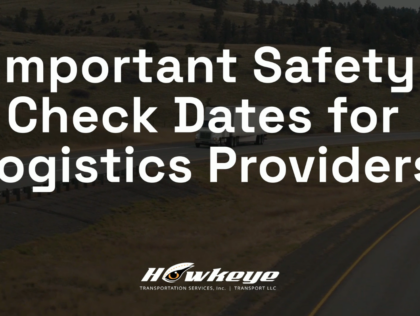The ELDT was created in an attempt to standardize Commercial Vehicle Driver training. The “entry-level driver training” (ELDT) regulations are intended to make sure drivers entering the industry can operate CDL-required vehicles safely.
The current ELDT requirements in Subpart E of Part 380 apply when a carrier hires a driver with less than one year of experience to drive a CDL-required vehicle. Evidence of a new driver’s experience is based on the driver’s application and the carrier’s background checks done during the hiring process.
As of February 7, 2022, the current ELDT rules go away, and new requirements will take effect. To obtain a CDL (Class B or A) for the first time, upgrade an existing CDL, or add certain endorsements to licenses for the first time (Hazardous, Passenger, School Bus, and/or Longer Commercial Vehicles – Doubles/Triples), a driver must attend training at an FMCSA-registered provider listed on the FMCSA’s Training Provider Registry (TPR).
The training must include specific classroom, range, and road training. The ELDT regulations include curriculum standards for classroom training, also known as Theory training, and road training, also known as Behind the Wheel (BTW) training. The BTW portion is divided into both Range and Public Road requirements. It also includes requirements for Facilities, Vehicles, Instructors, and Record-Keeping. There are separate but similar curriculum standards for obtaining your Class B and Class A license for the first time.
The Theory curriculum for a person obtaining their CDL is divided into 5 categories. At the end of the training, students must pass with a combined score of at least 80%. There is no minimum number of hours the training must take, but all topics must be covered and documented.
The required topics for the Class A curriculum are as follows:
- Basic Operation – Orientation; Control Systems/Dashboard; Pre/Post-Trip Inspections; Basic Control; Shifting/Operating Transmissions; Backing and Docking; and Coupling and Uncoupling.
- Safe Operating Procedures – Visual Search; Communication (i.e. horn, turn signals, etc.); Distracted Driving; Speed and Space Management; Night Operations; and Extreme Driving.
- Advanced Operating Procedures – Hazard Perception; Skid Control/Recovery, Jackknifing, and Other Emergencies; and Railroad-highway Grade Crossings.
- Vehicle Systems and Reporting Malfunctions – Identification and Diagnosis of Malfunctions; Roadside Inspections; and Maintenance.
- Non-Driving Activities – Handling and Documenting Cargo; Environmental Compliance Issues; Hours of Service Requirements; Fatigue and Wellness Awareness; Post-Crash Procedures; External Communications; Whistleblower/Coercion; Trip Planning; Drugs/Alcohol; and Medical Requirements.
BTW training is the hands-on practice of what is taught in the Theory portion of the training. There is no required minimum number of instruction hours, but all topics must be covered. The instructor must determine and document that each driver-trainee has demonstrated proficiency in all elements of the BTW curriculum and must separately document the number of clock hours spent on both the Range and Public Road.
There are additional Theory and BTW requirements that the registered training provider must provide for Entry-Level Drivers seeking to add Passenger and/or School Bus endorsements or Hazardous Materials Endorsement to their license for the first time.
Instructor requirements are also included in the regulations. Theory and BTW Road Instructors must hold a CDL equal to or higher than the class of vehicle used in training, including any necessary endorsements, and have at least two years of driving. BTW Range instructors do not need to currently hold a CDL, but they must meet the other requirements listed above
Record Keeping is another item addressed in the regulations. Copies of driver-trainee CLP and/or CDL (as applicable); Instructor qualification documentation; Training Provider Registration Form; lesson plans for Theory and BTW training curricula; and records of individual entry-level driver training assessments all need to be retained for a minimum of 3 years unless required by a particular state to be for a longer period.
Interested in finding out more about the opportunities available to you in this growing industry? CONTACT US to speak to one of our logistic experts.
Sources:
https://www.minntran.org/entry-level-driver-training-eldt-the-nuts-and-bolts-of-it/
https://www.fmcsa.dot.gov/registration/commercial-drivers-license/entry-level-driver-training-eldt
https://www.jjkellerlibrary.com/news-article/entry-level-driver-training-changes



